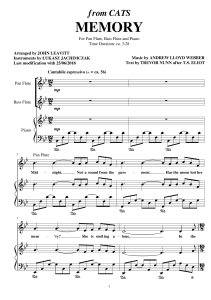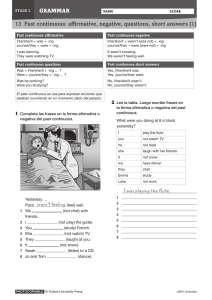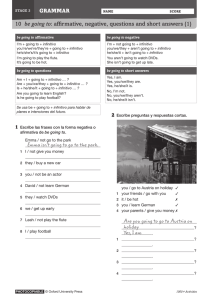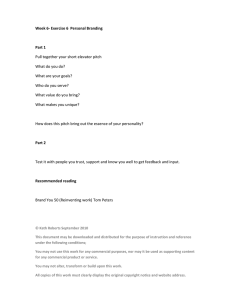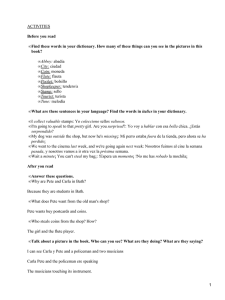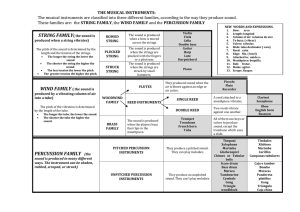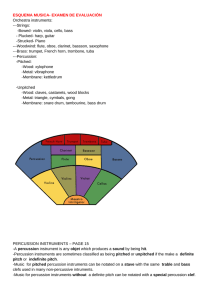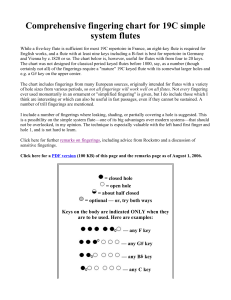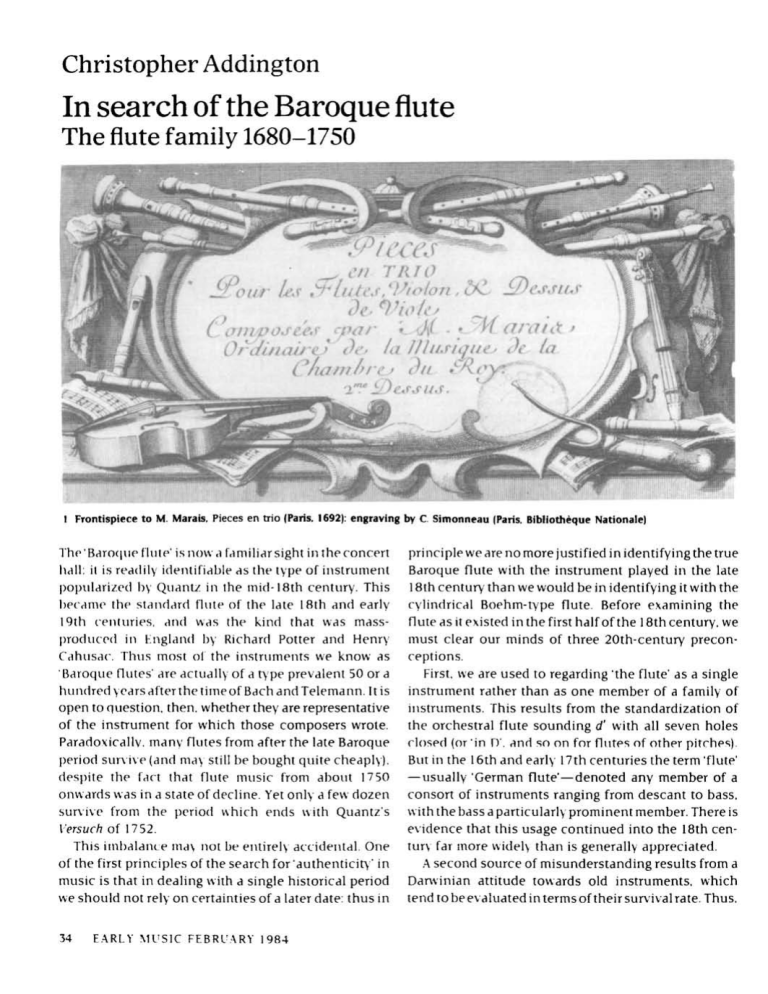
Christopher Addington
In search of the Baroque flute
The flute family 1680-1750
^ en TRIO
it our Us ff lutes.'Pioion.fyL IDessiu
Ccrmpojee.r cpar
'^<)(.yM,arai<X>
Ordinaire^ <)e> la UliLriquc Je la
n
Frontispiece to M. Marais. Pieces en trio (Paris. 1692): engraving by C. Simonneau (Paris. Bibliotheque Nationale)
The'Baro(|ue flute' is now a familiar sight in the concert
hall: it is readily identifiable as the type of instrument
popularized by Quantz in the mid-18th century. This
became the standard flute of the late 18th and early
19th centuries, and was the kind that was massproduced in England by Richard Potter and Henry
Cahusac. Thus most of the instruments we know as
Baroque flutes' are actually of a type prevalent 50 or a
hundred years after the time of Bach and Telemann. 11 is
open to question, then, whether they are representative
of the instrument for which those composers wrote.
Paradoxically, many flutes from after the late Baroque
period survive (and may still be bought quite cheaply),
despite the fact that flute music from about 17 50
onwards was in a state of decline. Yet only a few dozen
survive from the period which ends with Quantz's
Versuch oi 1752.
This imbalance ma\ not be entirely accidental. One
of the first principles of the search for 'authenticity' in
music is that in dealing with a single historical period
we should not rely on certainties of a later date: thus in
34
EARLY MUSIC FEBRUARY 1984
principle we are no more justified in identifying the true
Baroque flute with the instrument played in the late
18th century than we would be in identifying it with the
cylindrical Boehm-type flute. Before examining the
flute as it existed in the first half of the 18th century, we
must clear our minds of three 20th-century preconceptions.
First, we are used to regarding 'the flute" as a single
instrument rather than as one member of a family of
instruments. This results from the standardization of
the orchestral flute sounding d' with all seven holes
closed (or 'in D'. and so on for flutes of other pitches)
But in the 16th and early 17th centuries the term'flute'
— usually 'German flute'—denoted any member of a
consort of instruments ranging from descant to bass,
with the bass a particularly prominent member. There is
evidence that this usage continued into the 18th century far more widely than is generally appreciated.
A second source of misunderstanding results from a
Darwinian attitude towards old instruments, which
tend to be evaluated in terms of their survival rate. Thus.
if an instrument once existed in two versions, that now
represented by the larger number of museum specimens is often regarded as the 'standard' one. and the
other is treated as a deviation. But the preservation of
instruments is a haphazard affair: 20 years after their
manufacture, for instance, one model may become
fashionable while another, now unsuitable for more
recent music, will be discarded (especiallv if it is very
difficult r<i pla\j I believe this is precisely what
happened in the case of the Baroque flute. Historical
factors and geographical accident also have to be taken
into account: the British, for example, are a nation of
collectors, whereas the French have been extremely
unsuccessful in preserving their old instruments, largely
because of the Revolution.' This is particularly unfortunate in view of the fact that the flutes played in France
show a much greater variety and sophistication than
those of any other country: in the history of the flute,
France occupied the centre of the stage during the
whole of the period under examination, while England
lurked very much in the wings.
The third preconception concerns pitch. We have
become accustomed to the idea of an international
pitch standard based upon a value fora' that is defined
in terms at least as fine as one vibration per second.
Performers of Baroque music have tended to settle on a
pitch standard exactly a semitone below this (a'=415)
as being 'correcf for the music they play. But all the
evidence from the period shows that pitch varied
wildly, at least fromo'=350 to a'=500. This variation, of
about a 5th, arose from various factors.
According to Quantz, national pitch varied by almost
a 5th, with three main standards: the medium 'German'
pitch, which itself varied by six commasftwo- thirds of a
tone);'French chamber pitch', a minor 3rd below it: and
the high 'choir pitch', a minor 3rd above it, which was
used especially by the Venetians.
There were also pitches proper to certain instruments. Instruments tended to become fixed at particular pitches—the 18th-century German organ, for example, was often in choir pitch. We know from Quantz that
there was a similar association between wind instruments and French chamber pitch. Chamber and orchestral music may each have had an appropriate pitch.
Throughout the late Baroque there was a movement
towards a rationalization of pitch and its notation.
Corelli.Couperin, Bach. Rameau and Quantz himself all
played a leading part in the development of a fixed, international pitch. However, the process was necessar-
ily slow, as can be seen from Quantz"s description of a
prevailing situation that by our standards was chaotic.
The question of pitch is particularly important in
relation to wind instruments since they almost alone
have a fixed sounding-length, and their voice' is
defined entirely by that iength. In the case of the flute,
pitch is not merely a technical matter, since a difference
2 Five 18th-century ivory flutes (Paris, Musee Instrumental du
Conservatoire National Superieur de Musique)
EARLY MUSIC FEBRUARY 1984
35
of even a semitone will alter the timbre quite noticeably,
while larger variations involve a degree of difference
comparable to that between a soprano and an alto
singer. What then was the true Baroque flute like?
It is clear from written and—occasionally—musical
sources of the time thatthe following types of flute were
played in the first half of the 18th century:
6 Flute d'amour, flauto d'amore. An alto instrument
tuned to D at French chamber pitch (about a'=350) and
thus sounding a major or minor 3rd below the normal
pitch of harpsichords, and played at either of these
transpositions. It was treated as an instrument in either
B or B flat; in the latter pitch it was known as the flute
pastourelle.3
1 High octave flute (flauto piccolo, sopranino,'flutef).
In D, an octave above the 'ordinary' flute.
7 Tenor or intermediate bass flute. Quantz mentions a
low quart flute in A, but a more common instrument
seems to have been the bass flute in G, that is, the low
quint flute, based on the 6' organ pipe.
2 Fife or 'Swiss Pipe'. In B flat, a military instrument.
3 Descant flutes. Quantz mentions a 'little quart flute'
in G, a 4th above the 'ordinary' flute; there was also
certainly a high quint flute in A.
4 Flauto terzetto. A medium-high flute in D at choir
pitch, playing at about a'=48O-500. This would have
sounded a minor 3rd above the pitch of most harpsichords and orchestras. The terzetto was the ancestor of
the later 'flute in F but seems to have been of slightly
different construction.
5 Conceit flute. Known to Quantz as the 'ordinary'
flute, fhis was usually in D, but that D itself was highly
mobile, varying at least from a standard of a'=390 to one
ofa'=450. 2
8 Octave bass flute. In the D below that of the concert
flute.
Specimens of most of the flutes listed above survive
(and can be identified with surviving instruments) with
the exception of the descant flutes and also possibly
the original flauto terzetto and the low quart flute.
Bearing in mind the critical importance of a flute's
length, a good idea of the variety of instruments played
in the 18th century may be gained from illus.2, which
shows ivory flutes in the instruments museum of the
Paris Conservatoire. (This by no means covers the full
range of flutes in that collection; there is one flute with
Table I Baroque flute tunings.
Octave
Flute d'amour
in B
Bass flutes
Quint
Quart
O
tt9—i—
in Bt
in C
n iv 1—•
119, 11 n
transpositions:
CO"
Concert flute
in D
in D«
m
t
A
A5
D
C*
E
F*
G
G
A
B
A
D
E
F
F:
G
A
G
C
D
E1
E
F
G
Fs
B
C»
D
Ds
E
F'
E
A
B
C
Cf
D
E
D
G
A
B°
B
C
D
o
c'
F!
B
Terzetto
in F
in E
Descant flutes
Quart
Quint
-4-
IK+
D9—i—
Piccolo
in 8a
8
—y
—5
c
F
G
C
D
E
F
B
B
C
D
E
A
G'
A
B^
C
D
G
Fx
Gs
A
B
c!
F£
F!
G
A
B
E
D
E
F
G
A
D
'—n—'
o
V
B
'
s
©
ClOtM
_.}
©
Bottom note
{D fingering):
J' 0
-JL
Jk
1
o
1
o
This table is based on the flute methods of Quantz. Hotteterre and Correne and sources of music by Hotteterre. Couperia Philidor, Bach. Telemann. Quantz. Graupner and Molter.
36
EARLY MUSIC FEBRUARY 1984
zSuitfe e/iD la
cdtzCUf
r
•? Jaccm-'Jer
wee l&i
tie u£
3 Opening of a brunette from Jacques Hotteterre's collection Airs et brunettes
Bibliotheque Nationale)
a sounding length four times that of the smallest shown
here and thus pitched two octaves lower.)
Composers hardly ever specified the type of flute
they were writing for; and the boundaries between the
different types were blurred. Since the playing pitch
both of other instruments and of the individual flute
was so variable, many instruments could have played as
different kinds of flute in different performances. The
problem is one of notation, since all flutes were written
as if they were in D—at least during the first quarter of
the 18th century—whatever pitch they played at. The
note played with all finger-holes closed was written as
a" and called re even in music for the bass flute in G.
Thus it is often extremely difficult to judge simply from
the score which flute the composer had in mind.
In discussing this wide range of flutes I shall begin
with the three types in the middle range (nos.4-6) and
then go on to describe briefly the distinctly high- and
low-voiced varieties.
The middle range
As if the multiplicity of pitches were not complication
enough, there are two quite different designs of flute.
One, constructed in three pieces, was played in the first
quarter of the 18th century; the other, in four pieces,
superseded it in the second quarter.
tirez des meilleurs autheurs (Paris, 1721) (Paris,
such as the Chevalier (Boston, Museum of Fine Arts) are
thought to be of an earlier date. The first compositions
scored specifically for the flute are La Barre's five Pieces
pour la flute traversiere (Paris, 1702).
Over a dozen surviving specimens of this instrument,
all made either in France or by Frenchmen living
abroad, have now been identified. The design is distinctive and appears to be quite homogeneous, apart
from small variations in external appearance and
critical differences in the all-important matter of pitch.
The exterior consists of two long, plain tubes connected to three ornately turned smaller parts: the distinctive
cap to the headpiece (usually very long); the socket
connecting the head with the single middle joint; and
the foot joint(often of ovoid design). The mountings are
usually made of ivory. Other features distinguish this
flute acoustically from the later four-piece model: its
generally wider, less regular bore; larger and less
undercut mouth-hole; heavier walls; and larger fingerholes placed further down the flute. Of particular
interest is the fact that the end appears originally to
have been stopped with wood rather than cork.4 These
apparently small details combine to make a decisive
difference to the player's technique and the instrument's sound.
But most of the interest in this flute has focused on
the question of pitch. In his Versuch, Quantz several
The three-piece flute. The conical one-keyed flute was times mentions the low pitch that was a distinctive
invented in France in the second half of the 17th feature of the early French flute: 'Indeed', he says of the
century, probably by members of the Hotteterre family. entire new generation of wind instruments created by
For several decades the French had a virtual monopoly the French, 'they owe their existence to the low pitch.'
in flute making. The frontispiece (illus. 1) of a collection His identification of French chamber pitch as being a
of trios by Maraisfor flute or recorder (Paris, 1692) is the minor 3rd below the German standard of his own day is
earliest representation known to me of the new flute supported by the most famous of all the players of the
design. Some of the surviving specimens, however. three-piece flute, Jacques Hotteterre himself. inL'artde
EARLY MUSIC FEBRUARY 1984
37
4 A group of French musicians:
detail from a painting by Robert
Tournieres (1667-1752) |London. National Gallery)
preluder. written in 1719. he devotes a whole chapter
(chap.x) to flute transpositions. One of these, which
involves the overplaying of the two G clefs, he considers
crucial to flute technique because it enables one to
play tunes in their true tonality [or pitch—the French
ton could mean either], and in unison with the voice'.
This can mean only that the flute was not normally in
unison with the voice, but played a 3rd below. (For an
example of this overplaying technique. seeillus.3.from
Hotteterre's Airs el brunettes (Paris, 1721).)
The surviving examples of this flute are to be found in
38
EARLY MUSIC FEBRUARY 1984
museums and collections across the w orld; and although
their makers were French, nearly all of them seem to
have been owned by people living outside France.
Those that have survived in Britain have pitches of
about a'=405-15. while those in the German-speaking
countries are lower, at abouta'=390. However, that may
be an indication of the pitches prevailing in the
countries where the purchasers, rather than the makers,
lived. Only one of these instruments remains in France,
and it was almost certainly played in France: the flute
made by Naust (Strasbourg. c\ 700) and now in the Paris
Conservatoire. This is pitched at about a'=360. which
corresponds closely enough to Quantz's description.
There is one other surviving instrument which may be
at an even lower pitch: the flute by Du Mont (Paris.
cl692) in the Dayton C. Miller Collection, Washington.
DC. These two instruments are, I believe, the only surviving true representatives of the famous French flute
that created such a sensation in the early 18th century.
We have strong pictorial support for this view in the
well-known group portrait, attributed to Robert Tournieres and now in the National Gallery, London (illus.4),
which shows four musicians, thought to include La
Barre, Hotteterre and Marais, grouped around a piece
by La Barre. The ivory instrument held, with apparent
pride, by the player seated in the foreground is almost
entirely visible. From the proportions of the picture,
this flute is extremely long (and therefore low-pitched),
even longer perhaps than the Naust. Further visual
evidence is provided by the two offset holes in the third
and sixth positions, which are clearly visible in the
painting and have long puzzled writers. The principal
problem in the making and playing of long, low-pitched
flutes is that on any instrument larger than the concert
flute the distance between the finger-holes stretches
the hand to its limits, particularly as regards the third
and sixth holes. In the Naust flute, for example, each
hand must stretch about 15mm further than on the
average concert flute. On my own copy of this instrument I have brought these two holes within reach by
drilling them slightly high, in an offset position. I
believe this is the explanation of the extra holes in the
'La Barre' flute: the third and sixth holes were originally
so widely spaced that the player had them filled with
wax and new holes drilled in a more accessible position.
Most convincing, however, is surely the sound of the
instrument. It is difficult to believe that the instrument
that took France by storm and inspired an entirely new
form of musical composition was the rather blandsounding Baroque flute heard in the concert hall today.
The sound of the alto-voiced Naust flute is quite different: it has a far richer, more eloquent sound than any
other flute I have heard; and it is perfectly suited to the
music composed by the great flautists of the day, La
Barre, Hotteterre and Philidor. Not only is it tuned to a
very low pitch, but it is designed to play particularly
strongly in its lower range. Thus it sounds at its best
playing the notes at the bottom of the staff, which were
much favoured by those composers. It also has the
plaintive quality considered so typical of French flute
music.
The four-piece flute. Quantz, writing in 1752, tells us
that the four-piece version of the flute came into use
'about 30 years ago'. Naturally, the changeover from
one design to the other did not take place overnight.
Some early versions of the four-piece design, such as
those by Thomas Stanesby (i) and P. J. Bressan, date
from around 1720 and have some transitional features.
The latest appearance of the three-piece flute is in
Majer's Museum musicum theoreticopmcticum (Swabisch
Hall, 1732). This has an illustration of a flute, together
with a fingering chart, and they are particularly interesting for two reasons: the instrument has a very' advanced'
feature in the form of an extended footjoint giving c';
but this is connected to the out-of-date, single-piece
middle joint. Majer makes no mention of the new fourpiece design. But a transition of only ten years is quite
short, compared for example with the length of time it
took for the cylindrical flute to replace the conical one
in the 19th century.
The external appearance of the four-piece flute is
very different from that of its predecessor and is too
familiar nowadays to require description. Acoustically
there are a number of subtle but very important
differences, which affect all the sounding elements of
the instrument: the bore, the cork position, the embouchure, the finger-holes and the thickness of the
walls. The new kind of instrument has a more refined
sound than the old French flute, and a much wider
range: it can cover as much as three octaves and a
semitone and is very strong in most of the notes above
the staff, which in the French flute are little more than
falsetto notes. The instrument has a much clearer, more
precise tone and is extremely nimble, handling rapid
passage-work and dramatic jumps with ease. The compensating loss is that, even in its lower-pitched form, it
cannot quite match the sensuous, resonant quality of
the French flute.
There is nothing to suggest that immediately the
four- piece flute was invented it took the form exclusively of the Baroque flute played today. On the contrary,
there seems to have been a period of experimentation—
and of extreme confusion—lasting ten or twenty years.
Among the enormous range of pitches used at that time,
it is nevertheless possible to discern three basic levels,
described in the list above under types 4-6.
As one would expect, the majority of instruments
that have survived from this period are of the same type
as the modern Baroque flute at a'=415. They are
identical to the instruments that remained standard
well into the 19th century, except for some small
EARLY MUSIC FEBRUARY 1984
39
changes (especially in embouchure). The variability of different, and in the middle and upper registers the very
pitch, however, can hardly be overstated. At this time, narrow bore produces a haunting, veiled tone. It is as
almost every flute originally had several different corps expressive as the French flute, but its timbre is quite
de rechunge; indeed, it was largely the problem of pitch, different, being darker, more innig.
according to Quantz, that brought about the invention
I know of no surviving specimens of the original
of the divided middle joint.
flauto terzetto. The well-known 'flute in F' seems to be a
In its lower range, the four-piece flute remained at late 18th- and 19th-century type. Quantz, however,
the old French chamber pitch. This is the version speaks of flutes tuned to the high choir pitch, three
sometimes called the flute d'amour or flautod'amore. It is semitones above German pitch. He complains of their
100-150mm longer than the concert flute and plays unattractively shrill sound, and also makes an interestabouta major ora minor 3rd below a'=440. A numberof ing technical criticism. According to a well-established
these instruments have survived. The most interesting principle of flute making known well before Boehm's
thing about them is that, apart from their length, they do treatise, the diameter of a flute's bore and embouchure
not differ in any way from the concert flute; that is to should be in direct proportion to its length. Quantz,
say, the bore and embouchure are identical. This led me however, notes that these high-pitched flutes had the
some time ago to suspect that these two forms were not same bore as the'ordinary' flute, and were therefore not
really looked upon as different kinds of instrument, but built to the usual proportions. (This is not true of the
merely as the same flute at different pitches; logically, it later flute in F, whose makers seem to have heeded
seemed possible that one flute should be capable of Quantz's advice.) Some Baroque flutes sound considerbeing adjusted to both pitches. I have since discovered ably above a'=440 at their highest setting, and I think
that one of the flutes in the Paris Conservatoire does Quantz was indicating that some flute makers of his
precisely this: the remarkable Schlegel flute (described time were taking this tendency even further and cutting
another 50 or 60mm off the normal flute's length.
below in the appendix).
Although the flute d'amour has the same tuning as the
Thus there seem to have been three types of flute of
French three-piece flute, its sound quality is quite common bore but differing in length by up to 50%.
Table 2 The expanding Baroque flute
Embouchure
distance
Diameter of
bore (mm)
Diameter of
embouchure (mm)
500
(choir pitch)
19-13.5
9x8.5
fingering (Hz)
Instrument
Flauto terzetto
(from Quantz's description)
Approximate
pitch at a'
±475
Schuchart (Bate Collection); a typical concert
flute, at two corps de rechange settings
( 540
V 575
430 \ (German
405 1 pitch)
19.5-13.6
9.5x8.8
Fridrich (Vienna, Kunsthistorisches Museum);
a typical flute d'amour
683
350
(French
chamber pitch)
19-13.5
8.5x8.5
Scherer (Bate Collection); low flute d'amour
or pastourelle
715
330
19-13.5
8.9x8.3
Anciuti (Vienna. Kunsthistorisches Museum);
bass flute in ?G
970
280
19.5-14
9.5x9
Note: In all these cases, the last two figures remain almost unchanged.
Sources: Quantz's Versuch. Bate Collection Catalogue and author's own measurements
40
EARLY MUSIC FEBRUARY 1984
Stranger still, this anomaly is also to be found in the
bass members of the flute family. Table 2 shows the
measurements of several Baroque flutes whose pitch
varies by almost an octave. Thus it seems that many
flute makers of this period considered the flute to have
a certain ideal bore, which could be lengthened and
shortened at will, as it were a trombone. Those who have
observed this anomaly have naturally concluded that
the dimensions of the higher and the lower flutes are
deviations from the 'correct' proportions of the concert
flute. But Quantz, who surely would have known better
than anybody, expressly contradicts this, saying that
the dimensions of the four-piece flute were originally
based on the design of the low flute. This means that the
flute d'amour must be the archetype of the Baroque flute
from which the other forms are derived (in the Encyclopedie it is stated that the flute's range is particularly wide
in the d'amore setting); and it tells us a great deal about
the sound quality that people of the time expected of a
flute.
Before examining the way in which these differences
in the flute's design may have affected the playing of
the instrument, we ought to consider several important
and closely related events in the history of the flute that
took place at exactly the same time as the invention of
the four-piece design.
Until the early 1720s, all French flute music was written
in the French violin clef (Gl). In general, any music
written in this clef would have been played at a tuning
about a 3rd below a'=415, that is at about a'=35O. But
there were serious discrepancies. Italian musicians had
for many years been settling in France, and they
brought with them the exciting new^ouf italien. One of
the most striking differences between the two national
schools of music was that of taste in instrumental
colouring. The Italians played at a much higher pitch
than the French, using the modern treble clef (G2). In
theory, the two Gs were the same; in practice they must
have been several semitones apart. In France, music for
the harpsichord and the voice had always been written
in the treble clef, and the impact of the brilliant but
strident Italian violin must have been intense. The
everyday Baroque solution to the problem of fitting the
idiosyncratic French flute into this variety of contrasting sounds was transposition, as maybe seen in illus.3.5
Hotteterre's instructions to the bass are to 'play in this
clef in order to tune with the upper voices' (i.e. the
flutes). This technique of transposing by, as Quantz put
it, [imagining] a different clef for the notes' was part of
every flautist's technique.
Couperin seems to have been particularly troubled
by these discrepancies and went to great lengths to
unite the tastes'. He was a conscious innovator and
seems to have been aiming for an international pitch
standard based on a compromise between the \ow(doux)
French sonority and the shrill, harsh (hagard) Italian
one.6 He was the first Frenchman to write chamber
music in the modern treble clef. By doing so he
abandoned the low chamber pitch associated with the
dessus line and fixed the pitch of a piece according to
that of the bass line. This does not mean, of course, that
Couperin expected the wind instruments to alter their
pitch; instead, he intended that they should transpose
up to the key of the bass. This technique may perhaps
have been known as playing en amour. Couperin is not
usually thought of as a composer for the flute. His
music is too low-pitched and the keys he uses too
difficult. However, in his avertissement to the Concerts
royaux he does mention the flute as one of the instruments for which the music was intended, and if we
consider that he was writing for a low, transposing flute
(in his case, always by a minor 3rd), much of his writing
suddenly emerges as beautifully idiomatic for the
instrument. For example, the passage from Ritratto
dell'amore shown in ex. 1 is unplayable on the flute as
written (ex. la), but transposed backto the French violin
clef (ex.16), in which it must originally have been
written, it reads like a passage by La Barre or Hotteterre
(particularly with the passing c' sharp). By 1730, most
other French composers had followed Couperin's lead
and abandoned the French violin clef in favour of the
treble clef.
Ex.1 From Francois Couperin, Ritratto dell'amore: Nouveau concert
no.9 from Les gouts-reunis (Paris, 1724)
(a) as written
(b) transposed to the French clef
EARLY MUSIC FEBRUARY 1984
41
Although the French kept their primacy in performance on the flute, the new generation of composers
had completely lost the spirit of the gout frarifois, and
French composition for the flute went into a sharp
decline. Of the two leading flute virtuosos. Michel
Blavet wrote music that is indistinguishable from any
other compositions of the international style galant,
while Pierre-Gabriel Buffardin became so italianized
that he even styled himself II Sigr. Bufardini'.
The Germans took up the flute with almost as much
enthusiasm as the French, and before long it once again
became the 'German flute', in fact as well as name.
There is very little German flute music from before
1720. Bach was one of the pioneers, and his interest
may have been stimulated by the new four-piece
design, since only one of his compositions seems to
have been written for the bottom-heavy three-piece
flute. This is the early G major Trio Sonata BWV1039. a
work quite different in style from Bach's other flute
music.
At this time too the flute began to be heard with an
orchestra. It is notable that all the French flute music of
the first quarter of the 18th century was scored for very
small forces—for one, two or occasionally more flutes
playing together, often without a bass. The French seem
to have had the greatest difficulty in combining the
flute with any other instrument, even the harpsichord,
and it was not until the 1730s that a French composer
ventured to write a flute concerto. The Italians were
great orchestral innovators but they had little interest in
wind instruments, though Vivaldi began to compose for
the flute in this period. German composers took the
lead here; Bach, from his Brandenburg Concertos
onwards, was an important innovator.
Initially, the 'ordinary' flauto traverso was probably
the flu te d'amour. The conical-bore flute was entirely a
French invention, and it had acquired a status almost
equal to that of the violin, purely on account of its
mellow, inimitable tone colour. When the use of the
flute, in its altered four- piece form, became more widespread, musicians must naturally have preferred the
version which came closest to the sounds of the low
French flute—in other words, the flute d'amour. Quantz
describes the ideal flute tone as being 'thick, round,
masculine'. 'In general', he says, 'the most pleasing tone
quality on the flute is that which more nearly resembles
a contralto than a soprano, or which imitates the chest
tones of the human voice.' This is plainly a description
of the flute d'amour. Quantz's evidence is particularly
telling, for he was writing at a time when the standardi42
EARLY MUSIC FEBRUARY 1984
5 A flute player, possibly the imperial court musician F. J. Lemberger
painting |1709-24/5) by Jan Kupecky (1667-1740) (Nuremberg,
Germanisches Nationalmuseum)
zation of the flute at the higher pitch was already well
under way, and he himself contributed more than any
other to that process.
An interesting sign of the d'amore's popularity can be
found in the inventory of instruments belonging to the
Kapelle of Sayn-Wittgenstein. In this collection, the
wind instruments in the lower range far outnumber
their ordinary counterparts. Of the flutes, there are only
two ordinary instruments to three flutes d'amour (one of
which is described as 'large'). Again, the surprising
thing is that this inventory is dated as late as 1741, only
a decade before Quantz's Versuck I think it probable
that for the first 10—15 years after the introduction of
the four- piece design, the d'amore was played at least as
much as the type nowadays known as the Baroque flute.
The choice of different types of flute must have been
first and foremost according to function. The flute
d'amour is essentially a chamber instrument: it was the
flute on which one would play serious, expressive
music such as the trio sonata in the Musical Offering.
Most if not all of Bach's chamber music for the flute was
written for this instrument. The Sonata BWV1030 is
particularly important. Bach wrote two scores of the
keyboard part for this sonata, one in B minor, the other
in G minor. Oboists, perhaps frustrated by the lack of
any chamber music by Bach for their instrument, have
sometimes claimed the G minor as Bach's original
version, for oboe. But since we know that the flute at
this time was a transposing instrument, there is no
reason to suppose that Bach intended the two versions
for different instruments. They are merely written in
two different keys for the instruments used, flute and
harpsichord. It will be observed (ex.2) that the transposition used in this piece—two flats to two sharps—is
the same as that used by Hotteterre in the brunette
shown in illus.3. And it is the harpsichord part alone of
BWV1030 that survives in G minor.
about these compositions is their unity of idiom. They
all have a distinctly pastoral air, and in one of them
Telemann actually calls the instrument the 'flute pastourelle'. It is significant that the only piece in which
Bach combines the flute d'amour with orchestra is the
Pastorale from the Christmas Oratorio. (This group of
pieces is the only context in which 1 have encountered
the name 'flauto d'amore' in manuscripts of the period;
unless we are to conclude that the instrument was
seldom played, this must mean its use was so normal
that it was only exceptionally specified by name.)
The flauto terzetto also probably had its origins in
these experiments with the orchestra. Its descendant,
the flute in F, can hold its own in any band or orchestra
by virtue of its penetrating sound. There are two
concertos written for the terzetto by one of the Graun
Ex.2 J. S. Bach, Sonata in B minor BWV1030
brothers, who were Quantz's colleagues at the court of
Andante
Frederick the Great. But quite a lot more of the early
music for flute and orchestra may originally have been
scored for it. In view of Quantz's comment that the
Bach's two eldest sons also showed a preference for Venetians used to play atthe shrill choir pitch, it may be
the flute d'amour, whose sound is ideal for the empflnd- that the terzetto was the flute for which Vivaldi comsamer Stil of their music. With its strong vocal quality, posed. Certainly its chirpy sound is ideal for his 'Goldthe instrument would also be the perfect obbligato finch' Concerto RV428.
instrument in vocal music. Philip Bate7 has pointed out
that flute obbligatos in Bach's church cantatas are often High-pitched flutes
intended for the d'amore.
It is often stated that the true piccolo at the octave did
The soprano-voiced concert flute, on the other hand, not come into use until Beethoven's time. In fact, it was
owes its popularity and eventual predominance over very common in the Baroque era, from which some
other flutes to the rise of the orchestra. The develop- examples have survived. It is difficult to see what other
ment of orchestral music during this period is perhaps instrument Bach can have had in mind as the 'Fl. Trav.
the most critical factor in the history of the instrument. in 8a' of his choral scores. Corrette tells us that the
Thefluted'amour is unsuitable for combination with an piccolo was the correct instrument for playing the
orchestra for two reasons. First, it is at a different pitch tambourin pieces that were becoming fashionable at the
from the other instruments (though this could, of time he wrote his Methode (cl 740). The quart and quint
course, be solved through transposition). The main flutes were probably played mostly in France, as
disadvantage, however, is its mellow, intimate tone descant members of the three-piece flute consort. The
quality, which tends to blend rather than contrast with rather short instrument in Jan Kupecky's portrait of a
string instruments. Orchestral music demands a level of flautist (illus.5) may be of this type. And what were
uniformity and balance between instruments that we Bach's 'fiauti d'eco' in Brandenburg Concerto no.4?
take for granted, but which was signally lacking at the Were they perhaps two little quart flutes?8
beginning of the 18th century. The flute joined forces
with the orchestra only after its design and technique Bass flutes
had been considerably modified—that is to say, after it Various kinds of bass flute seem to have been played a
had become transformed from a basically low-pitched great deal throughout the Baroque period, though until
instrument into the soprano instrument that it has recently only one piece of music was known to have
remained. There are nevertheless a dozen or so pieces been composed for such an instrument—C. P. E. Bach's
for flute d'amour and orchestra written in the late 1720s delightful F major Trio Sonata WQI 63. (Modern editions
and early 1730s by Telemann, Graupner and Molter specify bass recorder for the 'Bassflote' called for here,
(possibly for one particular player). The striking thing but it is difficult to see why C. P. E. Bach should have
EARLY MUSIC FEBRUARY 1984
43
chosen to write such a sophisticated piece of music for
an obsolete instrument that would have been inaudible against a vinla, rather than for one which seems to
have been very popular at the time.)
By the middle of the century. French makers had
evolved an elaborate five-keyed design with the head
connected to a U-pipe; this instrument was either in G
or in the octave at D. Two other kinds of bass flute have
survived from this period, one by I. Beuker of Amsterdam (now in the Paris Conservatoire), the other by
J. M. Anciuti of Milan, 1739 (Vienna, Kunsthistorisches
Museum; illus.6). Both instruments are fascinating,
above all because their makers set out in opposite
directions to solve the problems of bass flute design. In
essence, the Beuker is simply an oversize four-piece
flute. Its length is double that of the concert flute, and
the maker followed the principles later approved by
Quantz and Boehm in making the diameter of the bore
and embouchure correspondingly large. The fingerholes are large and widely spaced, but the difficult third
and sixth holes are brought within reach by a doubleaction key system similar to that of the oboe. The
instrument is surprisingly light for its size.
The Anciuti flute is extraordinary in every respect,
and deserves further discussion. Especially remarkable
is the fact that although it has a sounding length almost
as great as that of the Beuker. its embouchure and bore
measurements are exactly the same as those of the
concert flute. The problem of reach on the Anciuti is
solved through two devices: a bent-back head-piece
made out of a single piece of wood, and an ingenious
system of cutting the finger-holes, which are raised
above the outside of the wall and cut at a very acute
angle with fine craftsmanship. Despite its curious
features, though, the Anciuti is easy to play and has a
lovely sound. Mersenne, discussing the problems of
the bass flute a hundred years before these two instruments were made, says: 'Still, one can remedy this
defect in the bass of the said flute by many keys, or by
breaking them and doubling them back, as is done in
the bassoon'.9 In other words, these instruments are
both of a very old design. (Even in Mersenne's time
there was nothing new about the use of keys to make the
diatonic notes reachable; but the concept of adding
keys for chromatic notes was revolutionary, and did not
take hold until the end of the 18th century.) The bass
flute seems to have been particularly favoured in
France. Included in the pieces in Hotteterre's Airs ex
brunettes are some trios in which a flute plays bass to two
higher-pitched flutes in consort, and several of the
44
EARLY MUSIC FEBRUARY 1984
6 Bass flute by J M Anciuti
fMilan. 1739) fVienna. Kunsthistorisches Museum. Sammlung alter Musikinstrumentel
transposed solo pieces are written for the low quart or
quint flutes. Two passages in Couperin's L'apothe'ose de
Lulli appear to have been scored for the bass flute in G;
another piece written specifically for it is Philidor's solo
La chasse (ex.3). Since such an instrument would have
been the flute equivalent of the oboe da caccia, it would
have been ideal for such a composition.
Ex.3 Pierre Danican Philidor. La c h a s s e . from op.3 (Paris, 1718)
J
u
'At present', says Quantz, of the 'unusual' types of flute for flute and obbligato harpsichord BWV 1032 is thought
like the flute d'amour, 'none approaches the regular to have been written in its present key of A maj or around
transverse flute in trueness and beauty of tone.' But this 1736, apparently in transposition from an original C
is a value judgement, and a highly partisan one at that, major (though the middle movement seems to have
which comes from the person most responsible for been raised a minor 3rd). These alterations are entirely
making these instruments obsolete. His use of the consistent with the idea that Bach was rewriting the
words 'at present is significant: they imply that the sonata for the soprano-voiced concert flute then coming
situation was not always so, and that the 'regular into fashion.10
transverse flute' had only recently begun to match the
Musicians now seem for the first time to have
'unusual' ones.
thought in terms of a fixed, international pitch system.
From the extremely complex state of affairs described Even unaccompanied flute pieces were now written in
above, it appears that the standardization of the flute remote keys: for example, of W. F. Bach's six duets for
was a far from straightforward process. Quantz is not as flutes, two are in E flat and one is in F minor, a key
reliable in questions of taste as he is in matters of fact: almost unheard of in such music. These were definitely
this is one of the rare areas in which we find something intended for the flute d'amour in B flat, but an earlier
self-contradictory and equivocal in the Versuch. On the composer would have written them in G major and A
one hand, he several times emphasizes the importance minor respectively and left the choice of flute to the
of the low tone of the flute, and speaks out strongly discretion of the player.
against the shrill sound of the terzetto flute then
This brings us to a very important set of pieces written
becoming prevalent. He complains that this tendency around 1740, Telemann's 12 Fantasias for unaccomwas 'denaturing' the flute and turning it into a fife. At the panied flute. This is the flautist's Well-tempered Clavier,
same time he says: 'I do not wish to argue for the very for it is the only collection of pieces for the flute
low French chamber pitch, although it is most advantageous systematically covering a range of different keys. Frans
for the transverse flute' (my italics) and decides in favour Vester has suggested (letter to the author) that the more
of the medium German pitch, which is 'neither too low 'remote' of these fantasias were meant for the flute
nor too high'. Perhaps many of his contemporaries d'amour. I am inclined to agree with him, but it is also
would have been convinced by these statements; but worth bearing in mind that at this time the ordinary
the jump from the old French pitch to that of Quantz's flute's technique was being extended to cover all keys,
'ordinary' flute was greater, if anything, than the and that Telemann may have been putting the instruinterval between Quantz's pitch and that of the shrill ment through its paces.
terzetto. If La Barre, for example, had heard Quantz play
Hitherto, the flute had had a variety of higher and
one of his soprano-voiced flutes, he might well have lower 'voices', each of which was only really at home in
found its pipsqueak sound as excruciating as Quantz the four or five keys it could play most naturally. As the
found that of the terzetto. (Quantz was probably aiming, Potsdam flautists began to use only one type of instruas a compromise, at a level somewhere at the lower end ment, the concert flute, they compensated by developof the middle German pitch. His own flutes appear, ing a technique that made a much wider range of keys
from their measurements, to have gone down to about available. Frederick the Great's rigorous solfeggios
<z'=400. It may be significant that quite a few flutes cover about 15 different keys. But one wonders how
made in France at the same time—by Bizey, Lot and widespread these techniques were. (Prussia, after all,
Leclercq—are tuned to the same pitch.) In fact, Quantz was still the only country in Europe whose soldiers were
was largely endorsing a process that had been taking drilled to march in step!) No one really succeeded in
place quietly during the 1730s and 1740s. Bach's Sonata turning the one-keyed flute into a fully chromatic
EARLY MUSIC FEBRUARY 1984
45
instrument: within 20 years of the Versuch, Kirst. who
must have know Quantz well, was already introducing
extra keys for the more difficult notes.
The traditional attitude to the flute had its champion
in Sans Souci itself. C. P. E. Bach, who was one of
Quantz's colleagues, seems to have been particularly
fond of the unusual types of flute. To Quantz, with his
reformer's zeal, this attitude must have seemed like an
irresponsible and retrograde desire for the chaos from
which he was trying to rescue the flute; and it no doubt
contributed to the poor relationship between the two
men. Quantz was trying, in fact, to do to the flute what
his employer was doing to Germany; his success was
every bit as swift and as far reaching. From the time of
his Versuch, a single type of instrument came to be
regarded as the flute: the orchestral instrument which is
known nowadays as the Baroque flute. By then, however, the Baroque era was almost at an end. Perhaps this
instrument could more aptly be called the Rococo
flute."
lam particularly grateful to Frans Vester. who sent me the list
ofcompositions for the fluted'amour'that he has prepared for
the second edition of his flute repertory catalogue.
Appendix: the Schlegel flute
One of the instruments on display in the instrument museum
of the Paris Conservatoire is an ivory flute (no. c.440) made in
Basle by Schlegel in the third quarter of the 18th century
(illus.7) In appearance it is a typical fliiled'amour, very similar
to the Scherer in the Bate Collection. (The museum has seven
other pieces of the flute which are not on display.) The
Schlegel flute is the missing link between i\\efliite d'amour, the
low-pitched old French flute and the German concert flute It
is unique in that all four of its parts (if we include the sliding
cork) can be adjusted in some way to alter the sounding
length. The upper middle joint has seven numbered corps de
rechange: there is a longer and a shorter lower joint; and the
foot joint expands by up to 14mm The expanding sleeve (or
register) is calibrated by numbers to match the different corps
de rechange. The silver key is also extendible.
There is a marked difference between the first corps de
rechange and the remaining six. as can be seen from illus.7.
No. 1 is 75mm longer than no.2; but no.2 is only 42mm longer
than no 7 (the shortest), and the intervening sizes diminish in
steps of 8-9mm The longer lower joint, with its wider
spacings for the finger-holes, obviously goes with no.l. the
shorter with the remaining six settings.
Between no.7 setting and no.l. the distance from the
middle of the embouchure to the tip of the foot joint increases
from 508 to 665mm; in other words, the flute can vary in
length by nearly a third. At its longest, the instrument has the
same dimensions as either a flute d'amour or the type of
46
EARLY MUSIC FEBRUARY 1984
7 Ivory four-piece flute by Schlegel (Basle, cl 730-40). shown at the
no.l setting, with corps de rechange (Paris. Musee Instrumental du
Conservatoire National Superieur de Musique)
instrument seen in the Tournieres painting (illus.4): it is less
than a quarter-tone flatter than the Naust flute in the same
collection. The note a'=440 is sounded in the C sharp
position: in other words, the flute in its no. 1 setting is in B flat
at modern pitch or in D at a tuning of a'=r350. This no.l
setting is almost certainly the corps d'amour mentioned in the
Flute allemande' section of the Encyclopedie. The other six
settings bring the instrument to exactly the proportions that
'Editors are prone to regard all transpositions that they find in 18thare most typical of the German 18th-century flute as described
by Quantz and as found in many extant examples. No.2 tuning century flute music as recorder transpositions, but that cannot be the
case here In was Hotteterre himself who originated the idea of
is around a'=415 (present-day Baroque' pitch), while no.7
recorder transpositions. inlheavernssementtohisLivrepremier. but his
sounds sharper than a'=440 (modern concert pitch). The suggestions are unconvincing—for example, that the D major suite
grades in between each correspond to a comma The flute should be transposed a major 3rd for the recorder, which would give
Ihe key of F sharp major, little used on any instrument, let alone the
therefore plays at two quite distinct levels, the low French
chamber or d'amore pitch, and the variable German pitch recorder.
The elaborately constructed programme of LapotheosedeLulli is in
probably used by most orchestras The intervals between
fact an allegory of Couperins ideas on the standardization of pitch
these two levels are: a minor 3rd at the lower end of the An article in which 1 analyse this work is forthcoming in Recherches
German tuning (no.2) and a major 3rd at the highest (no.7). sur la musique francaise classique
'JTieF/ufp (London. 1969). p 185
Both of these intervals occur as transpositions in German
"They were certainly not recorders in F Bach wrote a different
music for the flute d'amour (e.g. in Bach's flute sonatas).
version of the concerto for the Utter, in their home key. Thefiaulid'eco
Dr Kriekeberg. curator of the Berlin Musikinstrumentenmust have been flutes or recorders pitched a tone higher, in G. and the
Museum, has sent me information on Exhibit no. 1531 there, little quart flute', which is mentioned both by Quantz and in the
which consists of several ivory flute pieces by SchereT that Fncyclopedie. fits ihe bill exactly
''Harmonte umverselle. i (Paris. 1636). bk 5. sv Flute allemande'.
belonged to Frederick the Great. Dr Kriekeberg believes that
'"See R. L Marshall, J. S. Bach's Compositions for Solo Flute: a
1531 was originally a pair of flutes, each having a corps
Reconsideration of their Authenticity and Chronology'. JAMS, xxxii
d'amour. Thus Frederick definitely played the flute d'amour, (1979). pp.463-98. Marshall believes that, in the extant version. Bach
has altered the key relationship of the slow movement to the twoouter
which corroborates my belief that J. S. Bach's two Potsdam
flute works (the trio sonata in the Musical Offering and the E ones, raising il from the relative to the tonic minor, possibly because
in its original version the slow movement was the only one that went
major Sonata BWV1035) were originally intended for that
below the range of the concert flute.
instrument: the same is also true of much of C. P. E. Bach's
"After Quantz. Ihe flute d'amour continued to be played sporadicalflute music, particularly the Trio Sonata wql 62 in E major, a ly, enjoying a modest revival at the turn of the century. To meet this
new demand, the London workshop of Muzio dementi began in the
characteristic d'amore key.
1810s to produce copies of the earlier instrument—ihe first contribution, perhaps, to the early musical instrument revival1
'P. T Young, Twenty-five Hundred Historical Instruments (New York.
1982). lists only 102 extant flutes that can definitely be said to have
been made between 1670 and 17 50: of these. 5 5 were made in England
and 15 in France, and only two of those 15 have been preserved in
France.
'The use of exchangeable upper joints known as corps de rechange
enabled the pitch of many flutes to be altered by well over a tone, but
even this was not always sufficient to cover all the variations in pitch
between different kinds of instruments. Thus the flautist would
sometimes be obliged to transpose by a tone or a semitone. The
concert flute was therefore sometimes played as a 'flute in C. or E (or
even D sharp). The picture we get from Quantz. Corrette and Diderot
and D'Alembert's Encyclope'die (Paris, 1751-65) is that the corps de
rechange, when first invented, could alter a flute's tuning by as much
as three semitones, and that the span was refined at a later date to
between a semitone and a whole tone. Not many flutes have survived
with all their corps de rechange In general, any flute from this period
that has survived as one assembled piece should be treated as only
one version of a variable instrument
'This could be the instrument known as the flute a cinq pieds Writers
are aware of the existence of the flute d'amour in B. but seem to have
some resistance to the idea of one in B flat But in the 18th century any
flute was likely toad just its tuning by at least a semitone (I am sure, for
example, that the very low-pitched Scherer in the Bate Collection.
Oxford, originally had a corps de rechange that raised its pitch by a
semitone, and I have reconstructed such a joint from the dimensions
of another flute in Vienna). Conclusive evidence is provided by
Molter"s E flat Concerto for Flauto trav d'Amore and orchestra
(Karlsruhe, Badische Landesbibliothek. 307) In the manuscript
score, the flute d'amour part is written in G. a major 3rd higher, which
involves the same transposition as I use in playing Bach's E flat Flute
Sonata BWV 1031. Molter was personally acquainted with Bach and his
family
'See E Halfpenny. A Seventeenth-century Flute d'Allemagne'. GSJ,
iv (1951), p.42: the replica I have made of the Paris Naust includes
such a stopper, which 1 find gives a certain edge to the tone
The Original
Baroque Flute
As seen in the well-known Tournieres
painting: the French alto flute, for the music
of Hotteierre, l.n Barrc and Couperin.
1
[
I'
,
j
The C &: C "Naust" flute is copied from one
o( two surviving specimens. Il is tuned at the
old French Chamber Pitch, and will play
with other instruments at a'=4 15 or 440. It
can also tune up to Concert Pitch with an
extra "Rippert" joint.
Standard version: Grenadilla wilh
boxwood mounts: £338.
Other materials: bv arrangement wilh the
maker.
"Rippert" middle joint: £70.
Eaf h instrument is sold with instruc tions on how
to plav ai French Chamber Pitch, together with a
table of Hourterrc's G-Clrf transpositions.
C & C (Oxford) lid
2 Bladnn Close
Oxford OX2 SAD
Tel. (086'>) 59M5
EARLY MUSIC FEBRUARY 1984
47
'!'ir r» pen ^ lulmrrn fuln-f. |ii Dim)! m fliir li: iifUr
!\VWif lUlf'VV.'nU'rtiMi :n-t . li^i'rb jjnr ilomv II:(H
ti-H litfr Nti-li aHt-.^rf t-ilt \irlliofl-lt Inilli"
tVl- ti»r. h-'p llillfi- mtrlif Iriit (ituKf 5w i-iiln* Wif|»
1 Mezzotint of a clarinettist by Johann Elias Ridinger (1698-1767) (The Hague. Gemeentemuseum)
